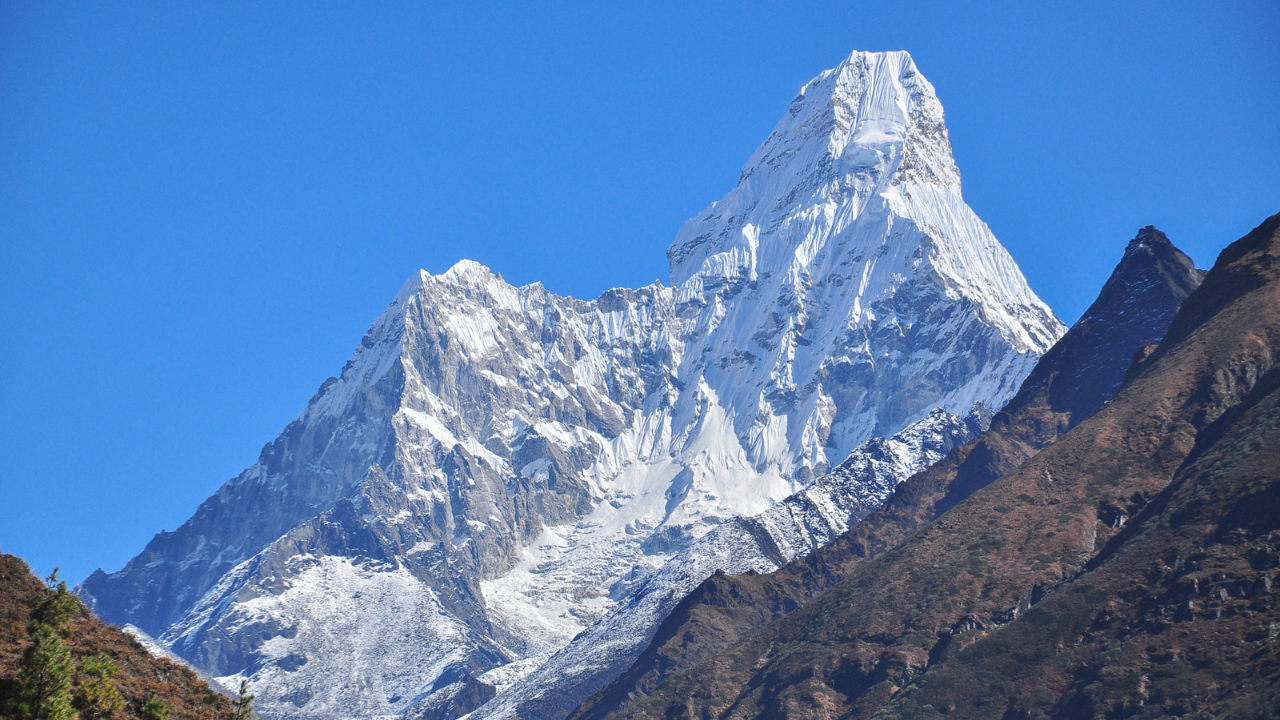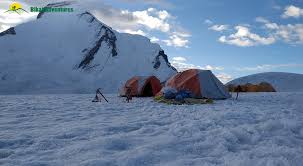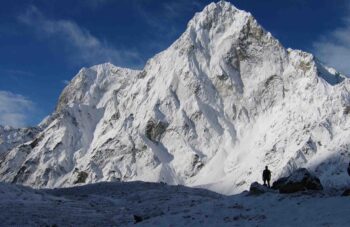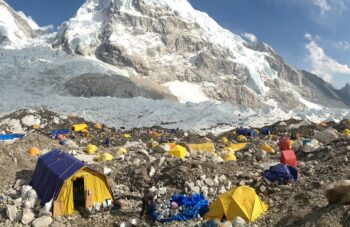AMA DABLAM EXPRESS EXPEDITION 2024
EXPRESS CLIMB HIGHLIGHTS. . .
- 1:1 Guide/client ratio. IFMGA certified guide with express guiding experiences, at least 1X Ama Dablam & several 8000M+ Summits, high level of support, experience, and guiding knowledge.
- Ama Dablam 6810M summit in 14 Days or less. Express itinerary
- South-west ridge route, Camp 1 – 2 (possible camp 2.9 or 3) strategy
- 🚁 Shared helicopter before and after the expedition
- 5 Weeks of hypoxic acclimatization equipment rental, programming, and initial training consultation.
Itinerary
-
Day 1: Arrival and Gear Check Day
Arrive in Kathmandu, Nepal.
Transfer to hotel.
Meet with expedition team for gear check and briefing.
Rest and prepare for the journey ahead.
-
Day 2: Kathmandu - Lukla - Namche (Acclimatization)
- Early morning transfer to the airport.
- Fly from Kathmandu to Lukla via helicopter, enjoying scenic views of the Himalayas.
- Upon arrival in Lukla, meet the trekking crew and begin trekking to Namche Bazaar.
- Trek through picturesque Sherpa villages and lush forests.
- Arrive in Namche Bazaar, the bustling market town and gateway to the Everest region.
- Acclimatization day in Namche Bazaar to adjust to the altitude.
- Explore the town, visit the local markets, and enjoy panoramic views of the surrounding mountains.
-
Day 3: Namche - Ama Dablam Base Camp (Via Helicopter)
- Early morning helicopter transfer from Namche Bazaar to Ama Dablam Base Camp.
- Enjoy breathtaking aerial views of the Himalayas during the flight.
- Arrive at Ama Dablam Base Camp and settle into the campsite.
- Orientation and briefing on expedition plans and safety procedures.
- Rest and acclimatize at base camp, preparing for the upcoming climb.
-
Day 4: Rest Day
Rest and relaxation day at Ama Dablam Base Camp.
Final gear preparations and equipment checks.
Briefing on climbing techniques and safety protocols. -
Day 5: Camp 1 Sleep
- Ascend to Camp 1 for acclimatization.
- Spend the night at Camp 1 to further adjust to the altitude and conditions.
- Enjoy stunning views of the surrounding peaks and glaciers.
-
Day 6: Camp 2 Touch and Back to Base Camp
- Climb to Camp 2 for acclimatization.
- Touch Camp 2 and assess conditions.
- Descend back to Base Camp for rest and recuperation.
-
Day 7: Rest Day
- Rest and recovery day at Base Camp.
- Hydration, stretching, and mental preparation for the upcoming climb.
-
Day 8: Camp 1
- Ascend back to Camp 1 for further acclimatization.
- Review climbing techniques and safety procedures.
-
Day 9: Camp 2
- Continue acclimatization and climb to Camp 2.
- Set up camp and prepare for the summit push.
-
Day 10: Summit Day and Return to Camp 2 or 1
- Summit day attempt of Ama Dablam.
- Reach the summit and celebrate the achievement.
- Descend back to Camp 2 or Camp 1 depending on conditions.
- Rest and recovery at the campsite.
-
Day 11-12: Contingency Days
- Additional summit attempts or rest days as needed.
- Flexibility to adjust the schedule based on weather conditions and team preferences.
-
Day 13: Base Camp - Lukla - Kathmandu Via Helicharter
- Pack up and prepare to depart from Ama Dablam Base Camp.
- Helicopter transfer from Base Camp to Lukla.
- Fly back to Kathmandu, reminiscing about the expedition and the memories made.
- Transfer to hotel in Kathmandu for a well-deserved rest.
-
Day 14: Departure
- Departure from Kathmandu, Nepal, marking the end of the Ama Dablam expedition.
- Transfer to the airport for onward journey or return home, carrying memories of an unforgettable adventure in the Himalayas.
Include / Exclude
Cost Includes:
-
- IFMGA/NMA certified Guide leader
- 🚁 Helicopter Kathmandu – Lukla – Namche – Base Camp – Lukla – Kathmandu
- $250 Individual tip pool. (This is not summit bonus tips) The tip pool will be fairly distributed among all Namas staff members. (Guides, porters, drivers, hotel security, and staff). Guest may personally hand in extra tips to our guides and porters)
- 1:1 Sherpa/client ratio. (Additional Sherpa Guide support can be arranged, extra charges apply)
- Head chef and 2 kitchen helpers ( Helpers increase with the number in climbing team members )
- 1 upon arrival and 1 day before departure. Hotel in Kathmandu. (Should clients return early from their expedition, clients will be responsible for their extra Kathmandu hotel bookings)
- All trekking permits (Khumbu Region Permit and TIMS)
- All internal-local transportation to and from the trekking trailhead
- Breakfast, Lunch, and Dinner on trek days. (one meal order)
- Lodge accommodation during the trek
- Full porter support to/from Base Camp
- Fooding and camp lodging arrangements at Base Camp on a full board basis (this includes 3-course meals, services of cook crew, camping equipment, kitchen tent, dining tent, toilet tent, shower tent, kitchen items etc)
- 30 kgs personal weight
- Single tent for individual use at Base Camp
- Solar charging at Base Camp (Comms will be given the first priority)
- Tents, pots, and pans for use on the mountain
- Expedition tents (2 or 1 person tents) Brands Salewa, Mountain Hardwear, Samaya equipment, Kailas
- Food and fuel above Ama Dablam Base Camp. Minimum choices from Camp I to Camp III.
- Meals and water at higher camps will be prepared by Namas guide member
- Training day with technical skills. This is not a course day and you should already be well familiar with abseiling and basic climbing techniques
- Ropes, climbing gear required for equipping the mountain, ice screws, snow stakes, etc
- Expedition 1st aid kit including antibiotics and medicines for use at altitude
- Insurance for Base Camp crew, climbing Sherpa, and porters
- Radio comms team at Base camp
- Frequent weather updates on expeditions
- Arrival pick-up and departure
- Welcome or Farewell Dinner
Cost Excludes:
- Visas and travel insurance
- Summit Bonus Tips ($500 – $700) Per Person
- Entertainment and food ( Kathmandu )
- Bottled drinks and beverages
- Evacuation (will be done in your account)
- Single supplement Charges
- Laundry, Phone services, Personal expenditure transactions
- Optional trips
- Tea breaks, chocolates or other snacks, and any meals besides breakfast, lunch, and dinner.
- Delay and cancellation because of natural phenomenon
- International flights to Kathmandu
Price per person
COST: $15750.00
(Shared 🚁) Ktm – Lukla – Namche – Base Camp – Lukla – Kathmandu
Please inquire about prices in your local currency. We accept payment in £GBP/ €EUROS/ $AUD
Deposit required: $4000 p/p
2024 AMA DABLAM DEPARTURES—
Autumn 2024
4th – 17th November
All-inclusive expedition. Guaranteed departure.
ADDITIONAL GUIDE—
$4000 USD
Only applies if there is only 1 climbing member.
EXPRESS CLIMB HIGHLIGHTS. . .
- 1:1 Guide/client ratio. IFMGA certified guide with express guiding experiences, at least 1X Ama Dablam & several 8000M+ Summits, high level of support, experience, and guiding knowledge.
- Ama Dablam 6810M summit in 14 Days or less. Express itinerary
- South-west ridge route, Camp 1 – 2 (possible camp 2.9 or 3) strategy
- 🚁 Shared helicopter before and after the expedition
- 5 Weeks of hypoxic acclimatization equipment rental, programming, and initial training consultation.
Usefull Information
PERSONAL CONSULTATION
Participating members will embark on an exceptional journey guided by a personal consultation with a dedicated representative from Namas, alongside a professional member of our esteemed altitude training center who previously have experience working with express climbing summiteers. Together, we will provide you with invaluable guidance, expertise, and support to ensure your transformational experience reaches its full potential. This personalized consultation will pave the way for a tailored approach that aligns with your unique aspirations and sets the stage for an extraordinary adventure of a lifetime.
PRE-REQUISITE CHECKS AND PREPARATIONS (MUSTS)
In order to ensure the highest level of readiness and safety, acceptance into the program will be granted to participating members following a thorough assessment and consultation process. It is imperative that client members meet our established pre-requisite requirements, and their personal fitness profiles will be meticulously evaluated. These pre-checks, consultations, and preparations form the bedrock of our approach, as they are vital components for successfully undertaking the Ama Dablam expedition within a condensed timeframe.
A significant focus will be placed on comprehensive pre-acclimatization and training methodologies. These pivotal elements will empower participants to adapt to the demanding altitude conditions and optimize their physical preparedness. By prioritizing these crucial aspects, we equip our members with the tools and resilience needed to conquer the formidable challenges that lie ahead on their extraordinary Ama Dablam express climbing journey.
PRE-HYPOXIC ACCLIMATIZATION AND GUIDED TRAINING
Hypoxic chamber acclimatization: Minimum 4 weeks, 5 weeks recommended.
Participating members will engage in a comprehensive hypoxic acclimatization and training regimen lasting for a minimum of 4 weeks (recommended duration max 5 weeks) to facilitate adaptation. The specific acclimatization timeline and training objectives will be tailored to each member’s individual profile, and it is essential that these targets are diligently met to ensure the success of the express climb. Optimal results are achieved when participants commit to a longer duration (5 weeks) of deliberate hypoxic chamber acclimatization, enhancing their ability to adapt effectively before commencing the renowned Ama Dablam base camp journey and embarking on the fast-track ascent to the summit.
ABOUT HYPOXIC TRAINING. . .
Reduction of oxygen during physical activity or exercise in order to strengthen the body’s ability to perform in low-oxygen conditions is the basis of hypoxic training methods. Those who frequently train in oxygen-deprived environments include athletes, military personnel and those who regularly need to perform in situations with lower levels of oxygen, like high altitudes or underwater.
Reducing inhaled oxygen can be achieved via hypoxic chambers or masks, whereas high altitude training utilizes the natural thinness of the air to lower oxygen levels. Simulating low-oxygen conditions is also possible through exercises or unique breathing techniques. These are several ways hypoxic training can be implemented.
Training under hypoxic conditions can prove quite useful, but those results come with a fair share of risks. It’d be wise to consider an individual’s suitability before opting for this kind of training. Any exercising program that intentionally decreases oxygen intake should first be discussed with a medical expert. It’s vital to consult with a healthcare professional before beginning any such routine.
HYPOXIC TRAINING PROGRAM. . .
The training program will be rigorous and demanding, spanning a period of 4-5 weeks. Additionally, members are expected to have commenced their own personal training regimen 4-6 months prior to embarking on the acclimatization and training phase.
This comprehensive program can be completed conveniently at home, utilizing hypoxic tents.
Each climber will receive an individualized training schedule and will undergo acclimatization over a minimum of 4-week period, gradually ascending to an altitude of approximately 6,000 meters. This strategic approach minimizes the need for extensive on-mountain acclimatization, which carries inherent risks and can be physically taxing.
As a result, the total duration of the expedition can be significantly reduced to a remarkable 2 weeks. By committing to this rigorous and carefully orchestrated regimen, you are embarking on a transformative journey towards conquering Everest, equipped with the necessary physical and mental resilience to realize your ambitious aspirations.
Please note that hypoxic chamber acclimatization may present certain challenges, such as potentially reduced recovery effectiveness and disruption to sleeping patterns.
It is important to consult with a healthcare professional before starting any new training program, especially one that involves intentional reduction of oxygen. It is also important to carefully monitor your body’s response to hypoxic training and to stop the program if you experience any adverse effects. Hypoxic training can be risky and may not be suitable for everyone.
STRATEGIC EMERGENCY SUPPLEMENTAL OXYGEN
A dedicated emergency provision of supplemental oxygen will be provided for the express climb approach. Members will benefit from an allocation of additional double to triple the usual amount of supplemental oxygen, with flow rates ranging from 4L per minute. Our team is committed to utilizing the highest-quality oxygen systems, ensuring optimal performance and reliability throughout the duration of the expedition. From Camp 1 (5800m) onwards, supplemental oxygen will be made available to all members for any emergency use. Your personal oxygen system will allow for a flow rate of up to 4L per minute (Maximum), catering to your specific needs and maximizing your comfort and safety at high altitudes.
The responsibility of carrying and depositing the oxygen supply rests with our experienced Sherpa team. Each member will be accompanied by 1 Sherpa certified guide, who will assist in shouldering the burden of carrying the personal oxygen systems. An additional member of the Sherpa team will be specifically designated to handle the transportation and depositing of oxygen systems at the higher camps. Through this meticulous arrangement, we ensure that your focus remains firmly on the climb itself, while our dedicated team attends to the logistical aspects, guaranteeing a seamless and supported experience.
AMA DABLAM EXPRESS SCHEDULE
The precise itinerary of the Ama Dablam Express expedition is designed to be highly flexible, accommodating individual circumstances. The departure schedules of our members need to be highly flexible. The climbing schedule and strategy will be shaped by factors such as weather patterns, snow conditions, and the progress of line fixing along the route.
Upon reaching base camp, our dedicated team will have already initiated comprehensive preparations, including oxygen deposits, Sherpa support, base camp set-up, route selection, and high camp arrangements. These meticulous preparations lay the foundation for a fast-track, successful ascent to the summit of Ama Dablam, allowing members to focus on the journey ahead.
We prioritize flexibility throughout the expedition, allowing for potential extensions if circumstances necessitate and participants desire. We recognize that a systematic approach is crucial for increasing the chances of success on an Ama Dablam climb. This entails considering factors such as experience, planning, skill, persistence, and training. A well-crafted strategy, combined with a solid system, serves as the key to a triumphant expedition to the peak of Ama Dablam.
EXPRESS EXPEDITION GOALS
At Namas Expedition, our mission extends beyond mere size or glamour. Our unwavering focus and top priorities revolve around three core principles:
- Summit Ama Dablam in 14 days or less: We are committed to attaining the pinnacle of success in reaching the summit of Ama dablam, prioritizing not only speed but also the highest safety standards. Our dedicated team strives to create a remarkable and memorable climbing experience, fostering an environment of camaraderie, fulfillment, and personal growth.
- In pursuit of these objectives, we consistently assemble and recruit the industry’s finest climbing guide leaders. 1 X Certified Guides are confirmed. These exceptional individuals possess unrivaled expertise, experience, and a profound commitment to safety and client satisfaction. With their guidance and leadership, we ensure that every climber receives unparalleled support, mentorship, and the highest standards of professionalism.
- Embodying Responsible, Ethical, and Sustainable Practices: We take great pride in being a beacon of responsible, ethical, and sustainable expedition operations. With a deep respect for the pristine natural environment of Ama Dablam and the communities that surround it, we diligently adhere to practices that minimize our ecological footprint, respect local cultures, and contribute to the preservation of the mountain’s fragile ecosystem.
AMA DABLAM EXPEDITION STRATEGY
Members will fly via helicopter 🚁 directly from Kathmandu to Lukla and then to Namche Bazaar, where they will conduct an acclimatization day.
The next day we fly via 🚁 helicopter to Ama Dablam base camp. Our team will set up 2-3 camps and climb through the safest route, the southwest Ridge. After establishing ourselves at Base Camp, and trekking up the moraine we will move higher to Camp 1 (5,807 meters/19,052 feet). From Camp 1, fixed-line ropes are used for traversing on solid granite and climbing on snow/rocky exposed ridges and vertical granite to Camp 2. Camp 2 (6,200 meters/20,594 feet), also known as the “YELLOW TOWER,” is reached after 60-70 feet of vertical rock climbing. This marks the start of the more difficult and objective dangerous part of the climb.
BASE CAMP (4529M) – CAMP 1 (5800M) AND CAMP 2 (6100M) ROTATION
Ama Dablam Expedition
From Days 4 to 12, we will review weather patterns and conduct acclimatization rotations after discussion with the members and get accustomed to the terrain and properly acclimatize our bodies for the final summit push. During these rotations, we will carry our personal gear to our camps and store it there.
The very exposed nature of the route on Ama Dablam provides exciting climbing, although the slope is not as steep as one might expect. Climbers with moderate technical experience can attempt this route. On summit day, the route crosses between ice cliffs and follows a snow arête directly to the 6,810 meter summit. However, the climb is physically demanding and requires long hours of climbing on the final summit day.
CAMP 2.1 OR CAMP 3 (6400M) (SITUATIONAL) AND SUMMIT BID
After evaluating the safety and conditions of the serac, we will decide whether to set up camp 3. If our lead Sherpa determines that the campsite is dangerous, we will make our summit attempt from Camp 2, starting in the early hours. (midnight or 1 aa)
The summit of Ama Dablam is wide and offers breathtaking views on clear weather days. Many of the 8000-meter and 7000-meter peaks are visible from the top of Ama Dablam, including Makalu (8463 meters) and the Baruntse range (7170 meters).
Equipment List
Mountain climbing Gears
- Helmet ( Black diamond, Petzel )
- A mountaineering harness, with adjustable leg loops.
- Ascender or Jumar
- Figure 8 or belay device
- Carabiners: 3 locking and 6 regular
- Crampon 10 or 12 point
Mountaineering boots
- Mountaineering boots suitable for above 6000m; La Sportiva Gsm2 or equivalent
- Hiking shoes for the trek to base camp with ankle protection
- Thermal mountaineering socks or equivalent: 6 pairs
- Liner socks or equivalent: 3 pairs
Body Layers
- 2 merino base layers: top / bottom set
- 1 mid layer top: breathable Underwear
- Lightweight Nylon Pants: 1 pair
- Hooded Soft Shell jacket To be worn over other layers
- Soft Shell Guide Pants: Gore Tex and breathable
- Hooded Hard Shell: Gore Tex and breathable
- Hard Shell Pants: Gore Tex and breathable, big enough to wear over your guide trousers
- Insulated Down Jacket with hood: North Face Himalayan parka or equivalent
- Insulated synthetic Pants: Worn primarily when climbing below Camp 2
- Long jones equivalent to Rab’s Polartec or equivalent: 2 pairs
Headgear and Hand wear
- Wool hat (ski hat)
- Sunhat: To shade your face / neck from the sun on a hot day
- Buff: To protect your neck / face from the sun
- Glacier glasses: Full protection with side covers or wrap around
- Ski goggles: To be worn on summit day in the event of high winds
- Lightweight synthetic liner gloves: For wearing on a hot day; 2 pairs
- Soft shell gloves: To wear for moderate cold / wind
- Shell glove with insulated liner: To wear for severe cold / strong wind
- Expedition Mitts for bad weather
Personal Gear
- Expedition Backpack: 65L pack should be large enough.
- Trekking Backpack: To carry on the trek to base camp. Simple and light.
- Sleeping Bag: Rated to at least -40°F. Goose down or synthetic
- Compression stuff sacks: 3 large ones; for reducing volume of the sleeping bag, down parka, etc., in your pack.
- High Quality sleeping pad (1 for base camp and 1 for high camps): Full length is preferred.
- Closed cell foam pad: To be used in conjunction with the inflating pad for warmth and comfort when sleeping.
- Trekking poles with snow baskets: Adjustable poles
- Cup: Plastic insulated cup for drinking
- Bowl: A plastic bowl for eating dinner or breakfast
- Spoon: Plastic spoon
- Head torch: 1 normal for base camp and 1 with remote battery systems for climbing at night. This will be used whilst climbing at night
- Sunscreen: SPF 50 or above
- Lip balm with sunblock
- Water bottles: 2 wide mouth bottles with 1 litter capacity
- Water bottle parkas (2): fully insulated with zip opening
- Thermos: 1 litre (buy a good ones to keep your water warm for longer hours)
- Pee bottle: 1 litre minimum bottle for convenience at night in the tent
- Toiletry bag: Include toilet paper and hand sanitizer and small towel
- Hand warmers & toe warmers
- Pen Knife or multi tool (optional)
- Camera: bring extra batteries and memory cards
- Personal solar charging system (optional but recommended)
- Travel Clothes
- Duffel bags (2) with locks: To transport equipment
- Base Camp extra Items: Kindle, I pad, smart phone, etc
- Snack food: Please bring a few days of your favourite climbing snack food such as bars, gels, nuts, beef jerky, etc. A variety of salty and sweet is recommended to give you extra energy.
- Small personal first aid kit: Include athletic tape, Band-Aid’s, Ibuprofen, blister care, personal medications, etc
- Medications and Prescriptions: Bring antibiotics (Azithromycin, etc.), and altitude medicine such as Diamox and dexamethasone*
Bundle Price per expedition: £250 | $300 p/p**
Client’s will try and receive full gears when they arrive in Nepal.
“Rental gears are exclusively used by and for Namas adventure clients rental purpose only. We do not rent gears to other operators. We only provide high-quality gears.”
Benefits of renting gears with us:
- Save money on gears that will end up costing you £2000 | $2700
- Save cost on extra airline baggage weights $60 per kg (on average)
- Saves you time and energy to go through all the research and hassle of finding the gears
Gears Included (Bundle package)
- -23C/-30C Kailas Mountain 900 Down Sleeping Bag
- 12 Point Kantz Crampons
- Climbing Helmet
- Climbing harness
- 3X Carabiners
- Z-lite sleeping foam mat
- L Duffle bag
-
 Best Seasons March to May, September to November
Best Seasons March to May, September to November -
 Group Size 2 To 10
Group Size 2 To 10 -
 Duration 14 Days
Duration 14 Days -
 Maximum Altitude 6812M
Maximum Altitude 6812M -
 Trek Difficulty Challenging
Trek Difficulty Challenging








Leave a Reply